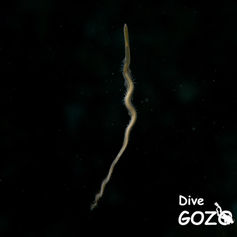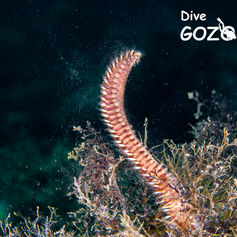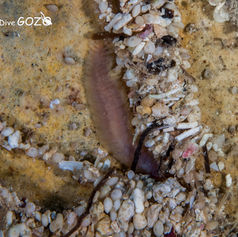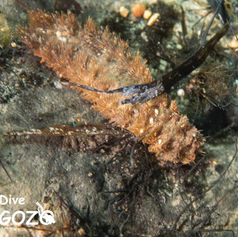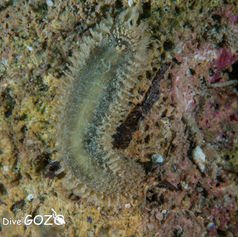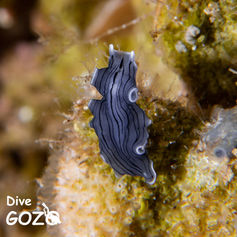Marine Worms
Any worm that lives in a marine environment is considered a marine worm. Marine worms are found in several different phyla (plural of phylum), including the Annelida, Phoronida, Echiura, Platyhelminthes, Nematoda, Chaetognatha, Hemichordata, Nemertea, and Sipunculid worms (peanut worms) - Wikipedia
Phylum Annelids (segmented worms)
Spaghetti worms
Phylum Annelids, class Polychaeta, family Terebellidae, species Eupolymnia crasscornis, commonly known as a spaghetti worm. These can be found on the sea bottom near rocks and sand. They live buried in the sand where they create a tube-like structure for themselves from sand and gravel which they cement together with a mucus-like secretion from a gland close to the mouth. Spaghetti worms generally do not leave their tube or reef crevices and are considered sedentary worms. Spaghetti worms have tentacles that extend outside their burrow for a considerable distance. The bodies of spaghetti worms are segmented. The tentacles can grow over one meter long. The tentacles are used to wrap around their prey and bring it closer to the mouth.
Nereididae (Family)
Phylum Annelids, class Polychaeta, order Phyllodocida, family Nereididae, species commonly known as rag worms or clam worms. It contains about 500 – mostly marine – species grouped into 42 genera. They may be commonly called ragworms or clam worms. Wikipedia
Lumbrineris latreilli
Phylum Annelids, class Polychaeta, family Lumbrineridae, species Lumbrineris latreilli. In appearance they are iridescent orange, pale pink or brown from different angles. They grow up to 300 cm and live mostly in muddy fine sand. They are a marine species and are found worldwide in temperate waters.
Fire worm/Bristle worms
Phylum Annelids, class Polychaeta, family Amphinomidae, species hermodice carunculata, commonly known as the fire worm or Bristle worm. It looks like a centipede with its elongated and flattened appearance and multiple segments. It has white silk bristles located on the side of its body, its colours are varied and range from greenish, to yellowish, to reddish pearly glow. The head is shown on the first segment and includes the eyes and other sensory organs. The bearded fireworm is a voracious predator that supplements its diet with plant material. It is a slow creature and is not considered a threat to humans unless touched by careless swimmers. The bristles, when flared, can penetrate human skin, injecting a powerful neurotoxin and producing intense irritation and a painful burning sensation around the area of contact. The sting can also lead to nausea and dizziness. This sensation lasts up to a few hours, but a painful tingling can continue to be felt around the area of contact. In a case of accidental contact, application and removal of adhesive tape will help remove the spines; applying isopropanol to the area may help alleviate the pain.
Scale Worms
Phylum Annelids, class Polychaeta, family Polynoidae, species Lepidonotus squamatus, commonly known as a Scale worms, it has twelve pairs of shells (plates) on the back. They come in different shades of yellow or light brown, usually with dark spots. The two rows of shells overlap on the back and they may grow to a body length of 5 cm.
Aphrodita aculeata "Sea Mouse"
Phylum Annelids, class Polychaeta, order Phyllodocida, family Aphroditidae, species Aphrodita aculeata Known as the 'Sea Mouse', The body of the sea mouse is covered in a dense mat of parapodia and setae (hairlike structures). Adults generally fall within a size range of 7.5 to 15 centimetres (3.0 to 5.9 in), but some grow to 30 centimetres (12 in). The sea mouse has two pairs of feeler-like appendages close to the mouth and does not have eyes. Locomotion is carried out by several small, bristly, paddle-like appendages. They are hermaphroditic which means that they have functional reproductive organs of both sexes. The eggs of one individual are fertilised by the sperm of another. - Wikipedia
Flabelligeridae Family
Phylum Annelids, class Polychaeta, family Flabelligeridae, species Flabelliderma sp 01. Known as the 'cage worms', notable for their head cage: the chaetae (bristle) of the first chaetigers (bristle pairs) form a fan-like arrangement surrounding the eversible head (able to be turned inside out).
Hesione pantherina
Leopard worms
Phylum Annelids, class Polychaeta, family Hesionidae, species pantherina, commonly known as a Leopard worm. The worm's body consists of a head, a cylindrical, segmented body and a tailpiece. The head consists of a prostomium (part before the mouth opening) and a peristomium (part around the mouth) and bears paired appendages.
Tube Worms
Mediterranean Feather worm
Phylum Annelids, class Polychaeta, family Sabellidae, genus Sabella, common names include the Mediterranean fan worm, the feather duster worm, the European fan worm, peacock worm and the pencil worm. It is native to shallow waters in the north eastern Atlantic Ocean and the Mediterranean Sea. European fan worms can grow to a total length of 40 cm and are usually larger in deep water. They have stiff, sandy tubes formed from hardened mucus secreted by the worm which protrude from the sand, and a two-layered crown of feeding tentacles which can be retracted into the tube. One of the layers forms a distinct spiral. The colour of the tentacles is variable but they are usually banded in orange, purple and white or they may be a uniform pale grey - Wikipedia
Calcareous tube worm
Phylum Annelids, class Polychaeta, family Serpulidae, Genus Serpula, species Serpula Vermicularis, common names include the Calcareous tube worm, fan worm, Red tube worm (although can be red or white). Serpulid worms are very similar to tube worms of the closely related sabella family, except that the former possess a cartilaginous operculum (lid like structure) that occludes the entrance to their protective tube after the animal has withdrawn into it. The tube is often curved, but is not tightly coiled as in some other related species. It can grow to a length of 20 cm (7.9 in), but is usually shorter than this. The anterior part of the worm protrudes from the tube and has a plume of about 40 feather-like radioles projecting from the second segment, or peristomium, which also houses the two eyes and the mouth. These can be sometimes divided into two. - Wikipedia
Filograna implexal
Class Polychaeta
Known as the Filigree worm and is in the family, Serpulidae which are of sessile, tube-building annelid worms in the class Polychaeta. The members of this family differ from other sabellid tube worms in that they have a specialized operculum that blocks the entrance of their tubes when they withdraw into the tubes. In addition, serpulids secrete tubes of calcium carbonate. Serpulids are the most important biomineralizers among annelids. About 300 species in the family Serpulidae are known, all but one of which live in saline waters. These generally live together in a colony.
Phylum Phoronids
Horseshoe worms
Phoronids, commonly known as Horseshoe worms are a small phylum of marine animals that filter-feed with a lophophore and build upright tubes of chitin to support and protect their soft bodies. There are twenty species, in two genera. They are part of the Brachiozoa, which also includes the brachiopods. Phoronids are worm-shaped, but with a gut that loops and exits the body near the mouth. That explains the name 'horseshoe worms'. If on rocks, they may live in colonies with their tubes become twisted around each other for support. Some species can dissolve away holes in rocks such as limestone, calcareous seashells or even cement piers; they then live in these holes which they line with their secreted tubes. Wikipedia
Phylum Echiurians (Spoon worms)
Bonellia viridis
Commonly known as the Green Spoonworm. The pale- to dark-green female, with a 15 cm-long, round or sausage-shaped body, lives on the sea-floor at a depth of 10 to 100 metres, concealed by burrowing in gravel or hiding in rock crevasses or burrows abandoned by other animals. It has two anchoring hooks underneath its body and an extensible feeding proboscis up to 10 times its body-length. It is mainly a detritivore, feeding also on small animals. The male is rarely observed: it has a flat, unpigmented body which grows to only 1–3 mm, taken up mostly by reproductive organs and devoid of other structures; it lives on or inside the body of a female.
Phylum Platyhelminthes
(flat worms)
The lack of circulatory and respiratory organs limits platyhelminths to sizes and shapes that enable oxygen to reach and carbon dioxide to leave all parts of their bodies by simple diffusion. Hence, many are microscopic and the large species have flat ribbon-like or leaf-like shapes. The guts of large species have many branches, allowing nutrients to diffuse to all parts of the body. Respiration through the whole surface of the body makes them vulnerable to fluid loss, and restricts them to environments where dehydration is unlikely as in the sea.
Phylum Nemertea
(ribbon worms)
Cerebratulus marginatus
These organisms have a specialised mouth known as a proboscis. This mouthpart has venom by which they immobilise small prey with. These are long, flattened worm that when fully extended grows to a length of over a metre, but they can contract to less than half its full length. Its width can be around 25 mm. The head tapers to a blunt point and the cephalic furrows are wide. The eyes contain dark pigment and are tiny and difficult to distinguish. Behind the mouth the body becomes dorso-ventrally flattened which often has wrinkles and folds that gives the worm its convoluted appearance. At the end of the body is a slender transparent caudal cirrus. The colour of this worm is somewhat variable; it is usually greyish-brown with pale or transparent edges, but the dorsal surface in older individuals is often darker than the ventral surface; other individuals are slate blue, dark brown or greyish-green.
- Wikipedia.



















